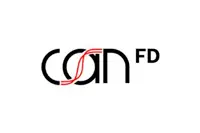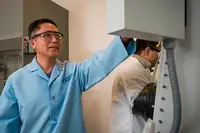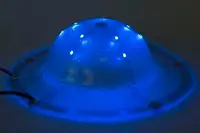Electronics News
Archive : 26 October 2015 год
 Microchip says Kvaser’s CAN and CAN FD IP will be featured in a range of products targeted at automotive and industrial applications. The devices are expected to appear in the middle of 2016.
Microchip says Kvaser’s CAN and CAN FD IP will be featured in a range of products targeted at automotive and industrial applications. The devices are expected to appear in the middle of 2016.
As part of the collaboration, Kvaser says it has benefited from Microchip’s integration expertise and test capabilities and notes the two companies are working together to test and develop improvements to Kvaser’s CAN FD technology.
CAN FD – flexible data rate – is an extension to the original CAN protocol that allows for a higher data rate and larger packet size. While a standard CAN network is limited to 1Mbit/s, with a maximum payload of 8byte/frame, CAN FD increases the effective data rate by allowing up to 64byte/frame without changing the CAN PHY. According to Kvaser, CAN FD can produce a ‘realistic bandwidth gain’ of at least three times what’s possible in CAN.
Lars-Berno Fredriksson, Kvaser’s president, said: “Kvaser is proud to support Microchip’s CAN FD developments – this is great validation of the work we have been doing in preparation for CAN FD.”
Orlando Esparza, Microchip’s CAN FD product line marketing manager, added: “Microchip has a good and long standing relationship with Kvaser, helping to minimise our device development cycle times. As a result, we have been able to quickly make design adjustments to meet ISO specification changes and requirements and plan to begin the roll out of controller products mid 2016.” Microchip has already released a number of automotive approved physical layer CAN FD transceivers.
Author
Graham Pitcher
Source: www.newelectronics.co.uk
 Building on earlier work, Fujitsu Laboratories has developed a technology which it says can turn biometric data, such as a map of the veins in the palm, into a cryptographic key. The approach, which uses randomised numbers to create a 2kbit feature code, is also said to avoid having to send biometric data across a network.
Building on earlier work, Fujitsu Laboratories has developed a technology which it says can turn biometric data, such as a map of the veins in the palm, into a cryptographic key. The approach, which uses randomised numbers to create a 2kbit feature code, is also said to avoid having to send biometric data across a network.
According to the developer, previous technologies required confidential data to be encrypted with biometric data. When decrypted, the feature data extracted from biometric data would then be matched with the encrypted data. It says this can be a security risk when used across an open network, such as The Cloud.
To solve the problem, Fujitsu uses random numbers to decrypt confidential data that has been encrypted using biometric data. As a result, confidential data can be encrypted and decrypted with the user’s biometric data, removing the need for cryptographic key management.
In encryption, confidential data is converted with an error correcting code and a random number is added to the whole. That data is then further converted using an error correcting code. The 2kbit feature code extracted from the biometric data is then added to generate the encrypted data, which is registered in the server.
The decryption code, after being converted into secure data, is sent to the server. The code is generated by converting a random number using an error correcting code, then adding the feature code extracted from the biometric data. As different random numbers are used for encryption and decryption, a different, secure decryption code can be generated.
Fujitsu is now looking to improve the speed of decryption processing and to expand the types of information that can be encrypted. The team is also planning to expand the types of applicable biometrics, including fingerprints.
Author
Graham Pitcher
Source: www.newelectronics.co.uk
 Researchers at the University of Delaware and the Chinese Academy of Sciences have used nanotechnology to boost the energy density of dielectric capacitors.
Researchers at the University of Delaware and the Chinese Academy of Sciences have used nanotechnology to boost the energy density of dielectric capacitors.
One of the keys to the success of the new capacitor is said to be its interdigitated design, which decreases significantly the distance between opposing electrodes and therefore increases the ability of the capacitor to store charge. The capacitors also feature a nanoscale electrode, whose high breakdown voltage means the dielectric material functions as an insulator more readily.
“We achieved an energy density of about 2W/kg, which is significantly higher than that of other dielectric capacitor structures reported in the literature,” said Delaware’s Professor Bingqing Wei, pictured.
“To our knowledge, this is the first time that 3D nanoscale interdigital electrodes have been realised in practice. With high surface area relative to their size, carbon nanotubes embedded in … 3D architectures have enabled us to address the low ability of dielectric capacitors to store energy.”
According to the team, applications for its capacitor design could include accessory power supply and hybrid power systems.
Pic: Kathy Atkinson/University of Delaware
Author
Graham Pitcher
Source: www.newelectronics.co.uk
 imec and CMST, its associated lab at Ghent University, have developed thermoplastically deformable electronics technology that is said to enable the creation of low cost 2.5D free form rigid electronic objects. The technology is being tested by Philips for use in LED lamp carriers, a downlight luminaire and a omnidirectional lightsource.
imec and CMST, its associated lab at Ghent University, have developed thermoplastically deformable electronics technology that is said to enable the creation of low cost 2.5D free form rigid electronic objects. The technology is being tested by Philips for use in LED lamp carriers, a downlight luminaire and a omnidirectional lightsource.
The approach is based on what are described as ‘meander shaped interconnects’. This, say the partners, is a robust technique that creates dynamically stretchable elastic electronic circuits – including LEDs – which can then be embedded in thermoplastic polymers. Although created on a flat substrate, using standard PCB production equipment, the circuit can then be shaped using such techniques such as vacuum forming, high pressure forming or even injection moulding.
Imec and CMST believe deformable electronic circuits will not only enable novel lamp designs, but also novel ambient intelligence and wearable products.
Author
Graham Pitcher
Source: www.newelectronics.co.uk

